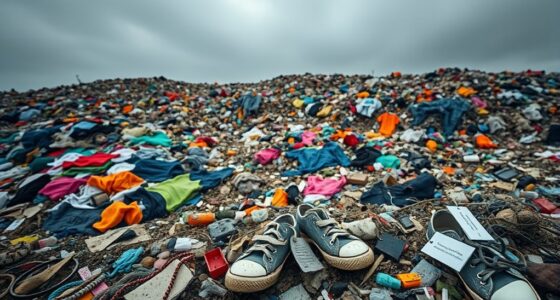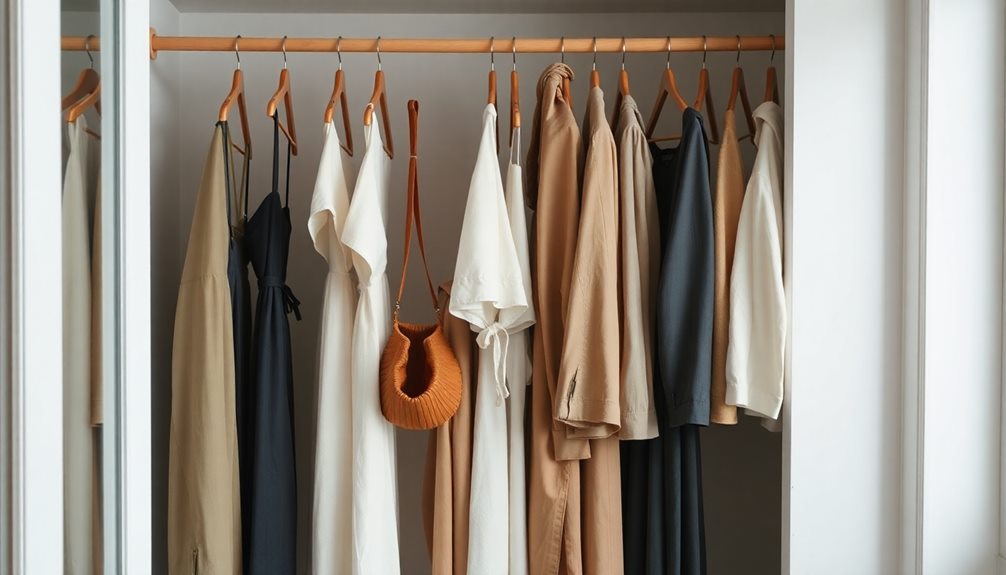Achieving sustainable fashion begins with you. By opting for eco-friendly materials such as organic cotton and backing brands that prioritize ethical practices, you can make a positive impact. Embrace the circular fashion model – recycle, upcycle, and consider rentals instead of always buying new. Taking good care of your garments prolongs their lifespan and reduces waste. Remember, implementing a one-in, one-out policy helps keep your wardrobe refreshed without excessive consumption. Supporting innovations like 3D printing and on-demand manufacturing also aids in waste reduction. By making mindful choices, you are contributing to a more sustainable future. Interested in more ways to transform your wardrobe sustainably? There is a wealth of information waiting to be discovered!
Key Takeaways
- Embrace circular fashion by prioritizing recycling, upcycling, and using sustainable materials to reduce waste and extend garment life.
- Support brands with take-back schemes and ethical practices, as 25% of consumers are willing to pay more for sustainable options.
- Opt for eco-friendly materials like organic cotton and recycled fabrics to minimize environmental impact and carbon emissions in fashion production.
- Practice mindful consumer choices, such as thrift shopping and adopting a one-in, one-out policy, to lower your wardrobe's ecological footprint.
Understanding Sustainable Fashion
Sustainable fashion focuses on creating clothing that considers environmental, social, and economic impacts, aiming to reduce waste and promote renewable resources. This approach is imperative given that the fashion industry contributes nearly 10% of global carbon emissions. By utilizing sustainable materials, brands can minimize their environmental impact and help combat climate change.
The circular economy concept plays an important role in sustainable fashion, emphasizing the significance of recycling and reusing materials to reduce clothing waste. With approximately 92 million tonnes of clothing waste generated annually, adopting this model is essential for a more sustainable future. As a consumer, your behavior greatly influences this shift.
A growing number of people are now aware of the unsustainable lifecycle of clothing, leading to increased demand for ethical fashion. Studies show that 1 in 10 customers actively consider the carbon footprint of their purchases, with 25% willing to pay more for sustainable brands.
This change in consumer behavior is pushing the fashion industry toward more responsible practices, ultimately fostering a culture that values sustainability, ethical production, and reduced waste. Embracing sustainable fashion isn't just a trend; it's a necessary evolution.
The Impact of Fast Fashion
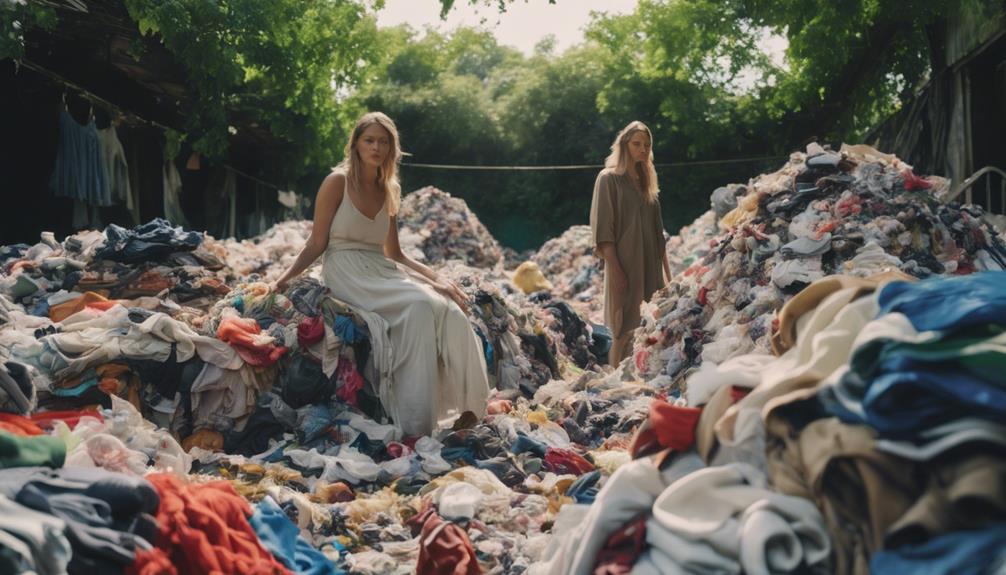
Fast fashion wreaks havoc on the environment, contributing greatly to carbon emissions and waste. This industry accounts for about 10% of global carbon emissions, notably driving climate change and environmental degradation. You might be surprised to learn that fast fashion generates approximately 92 million tonnes of clothing waste each year, with a staggering 60% of these items ending up in landfills or incinerators after just one year.
Here's a breakdown of the impact:
| Issue | Statistic | Consequence |
|---|---|---|
| Carbon Emissions | 10% of global emissions | Climate change |
| Clothing Waste | 92 million tonnes annually | Landfill overflow |
| Synthetic Fibers | Major contributor to microplastics | Marine pollution |
| Recycling Rates | Less than 1% | Resource loss of $100 billion |
The fast fashion model encourages overconsumption, leading to a 36% drop in clothing utilization over the past 15 years. You're buying more but wearing less, which results in increased textile waste. Adopting sustainable practices and utilizing recycled materials and eco-friendly materials can help combat these issues.
Key Sustainable Practices
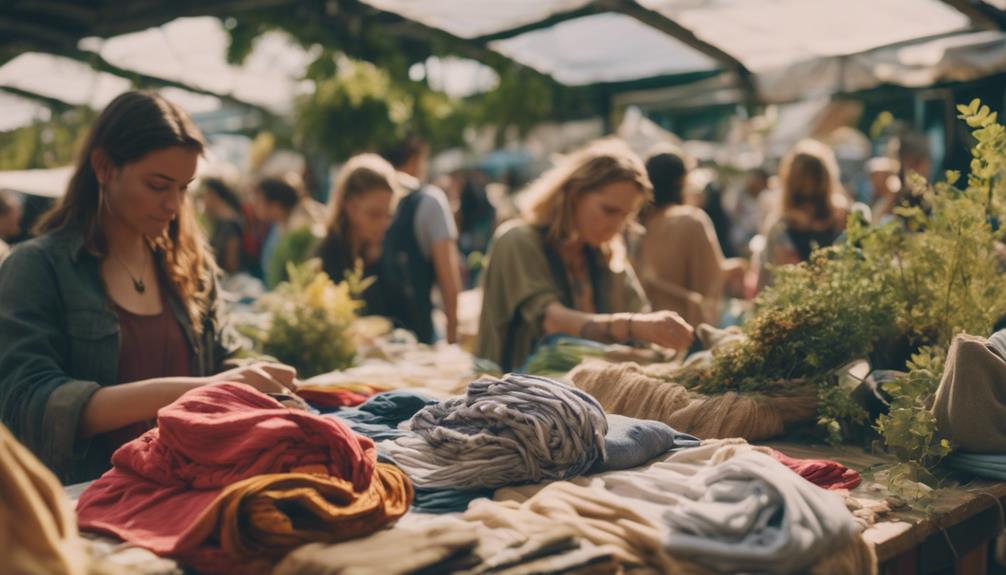
By prioritizing eco-friendly materials and innovative practices, the fashion industry can considerably lessen its environmental footprint and promote a more responsible approach to clothing production. Using sustainable materials like organic cotton and recycled fabrics helps reduce the environmental impact, as the industry contributes up to 10% of global carbon emissions.
Adopting a circular fashion model is essential; it emphasizes recycling and repurposing garments to minimize clothing waste, which currently stands at around 92 million tonnes annually. Business models like fashion rental and made-to-order clothing further aid in reducing overproduction, with the rental market projected to reach $2.33 billion by 2030.
Implementing innovative technologies, such as virtual sampling and AI-driven design, allows brands to optimize resources and reduce waste, making the production process more efficient. Additionally, eco-friendly packaging enhances sustainability efforts, demonstrating a commitment to responsible fashion.
As consumers become more aware of their purchasing decisions, the demand for sustainable and ethical brands continues to grow, with 25% willing to pay more for such options. Together, these key sustainable practices can drive meaningful change in the fashion industry.
Mindful Consumer Choices

As the fashion industry embraces sustainable practices, making mindful consumer choices has become increasingly important for reducing environmental impact. Over 60% of you are prioritizing the environment when shopping, highlighting the shift toward sustainable fashion. You're not alone—more than 65% are willing to pay extra for ethical fashion options.
One effective approach is to frequent thrift stores and consignment shops, which can dramatically lower your wardrobe's environmental impact while offering unique items. Adopting a one-in, one-out policy can also enhance wardrobe sustainability. By donating or recycling an item you no longer wear whenever you buy something new, you contribute to a more responsible fashion cycle.
Research indicates that 71% of millennials are prioritizing sustainability in their shopping habits, showcasing a generational shift toward conscious consumer behavior. By making these mindful consumer choices, you not only promote sustainable fashion but also send a message to brands about the importance of ethical practices.
Clothing Care and Maintenance

Taking care of your clothes is essential for prolonging their life and reducing waste.
By learning proper garment care techniques and basic repair skills, you can keep your favorite pieces looking great and avoid unnecessary replacements.
Let's explore how simple maintenance and tailoring options can make a big difference in your wardrobe's sustainability.
Proper Garment Care Techniques
Proper garment care techniques can greatly extend the life of your clothing while reducing its environmental impact. By taking the time to implement proper garment care, you can extend clothing use and minimize waste.
Start by following the care instructions specific to each fabric, like washing at lower temperatures and air drying whenever possible. This not only prevents damage but also reduces the need for replacements.
Incorporate maintenance practices like laundering with eco-friendly detergents and avoiding over-washing. These steps will keep your clothes in great condition while cutting down on water and chemical usage. Additionally, consider using tools like fabric shavers to eliminate pilling and keep your garments looking fresh.
Learning basic clothing repair techniques can also play a significant role in sustainable fashion. Simple skills, such as sewing on buttons or patching holes, can prolong the lifespan of your favorite pieces.
Repair and Tailoring Options
Exploring repair and tailoring options can breathe new life into your favorite garments, making them fit better and last longer. By learning basic repair techniques like sewing buttons or fixing hems, you can save money and reduce textile waste. When you invest in professional tailoring services, you maximize the utility of your existing wardrobe, promoting sustainable practices.
Here's a quick guide to help you understand the benefits of repair and tailoring:
| Option | Benefits | Impact on Waste |
|---|---|---|
| Basic Repair | Easy to learn, saves money | Extends garment life |
| Professional Tailoring | Perfect fit, rejuvenates clothes | Reduces need for new purchases |
| Maintenance Tips | Keeps garments looking new | Decreases frequency of buys |
| Apps like Sojo | Convenient tailoring and repair | Simplifies maintenance |
| Regular Care | Increases garment lifespan | Lowers overall textile waste |
Embracing Circular Fashion
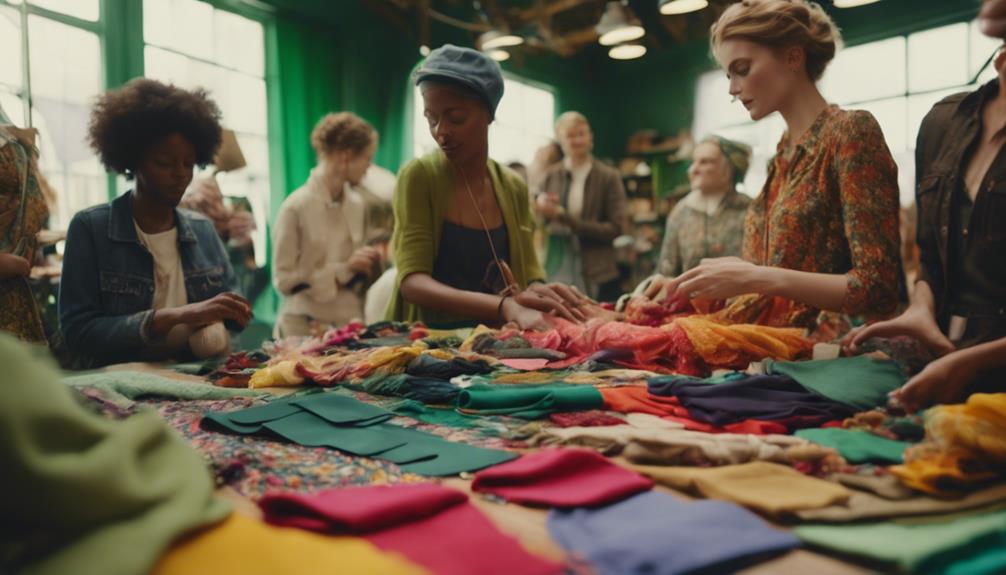
Embracing circular fashion means actively participating in a system that prioritizes recycling, upcycling, and sustainable materials to reduce waste and environmental impact in the industry.
By choosing circular fashion, you extend the lifecycle of your clothing, minimizing textiles ending up in landfills. With around 92 million tonnes of clothing waste generated annually, this approach is essential for waste reduction.
You can support sustainable and ethical brands that implement take-back schemes, allowing you to return old garments for recycling or repurposing. This not only keeps materials in use but also aligns with your values as a conscious consumer.
As consumer demand for sustainable options grows, with 25% willing to pay more for ethical choices, brands are increasingly adopting practices that promote circular fashion.
Look for clothing made from biodegradable materials or those that utilize upcycling techniques, ensuring your wardrobe is both stylish and environmentally friendly.
Innovations Shaping the Future
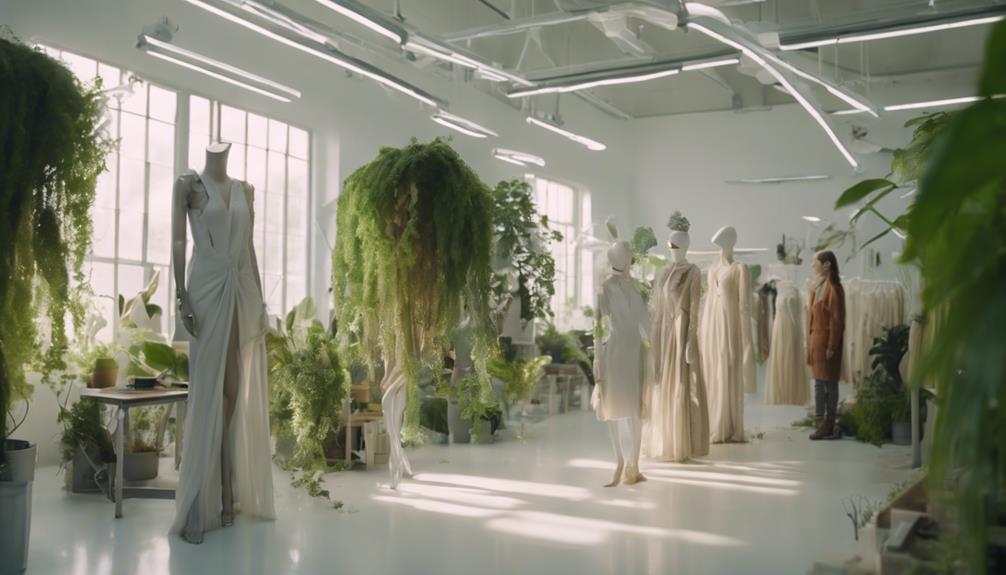
As you explore innovations shaping the future of sustainable fashion, you'll notice exciting developments in cutting-edge materials and circular economy practices.
These advancements not only enhance the quality and sustainability of clothing but also promote a more responsible approach to consumption and production.
Cutting-edge Materials Development
How are cutting-edge materials transforming sustainable fashion and paving the way for a greener future?
Innovations in alternative textiles, like biodegradable materials and recycled fibers, greatly reduce resource consumption and waste in production. By incorporating these materials, you're helping to create a more sustainable fashion landscape.
Technologies such as 3D printing and virtual sampling minimize material waste by enabling designers to produce digital prototypes instead of physical samples. This not only fosters a sustainable design approach but also allows for rapid iterations without excess waste.
On-demand manufacturing further aligns production with actual consumer demand, cutting down on excess inventory and waste.
AI-driven design tools enhance resource allocation and visualization, reducing overproduction risks. These technologies empower brands to make more informed decisions, thereby promoting sustainability.
Additionally, blockchain technology is revolutionizing traceability in the supply chain. This guarantees that materials are ethically sourced and produced, fostering consumer trust in sustainable fashion brands.
Incorporating these cutting-edge materials and technologies, you're actively participating in the shift towards a more sustainable future in the fashion industry. Each choice you make contributes to a greener planet.
Circular Economy Practices
Circular economy practices in fashion are revolutionizing the industry by transforming waste into valuable resources and promoting sustainable consumption.
By focusing on recycling and upcycling programs, brands are finding innovative ways to reduce the staggering 92 million tonnes of clothing waste generated annually. You can support these efforts by choosing garments made through zero-waste design principles, which minimize fabric scraps during production.
The rise of the fashion rental market is another exciting aspect of the circular economy. It's projected to reach $2.33 billion by 2030, encouraging shared consumption and reducing the need for new production. Participating in fashion rental services allows you to enjoy new styles without contributing to clothing waste.
Additionally, many brands are implementing take-back schemes, inviting you to return old clothing for recycling. These initiatives foster a closed-loop system, ensuring materials are kept in use rather than ending up in landfills.
Frequently Asked Questions
How Can Sustainable Fashion Be Achieved?
You can achieve sustainable fashion by choosing eco-friendly materials, supporting rental services, and recycling old garments. Educate yourself on brands' practices, and remember, every informed purchase you make contributes to a healthier planet.
How Does Sustainable Fashion Help People?
Sustainable fashion's like planting seeds in fertile soil; it nurtures communities. It boosts economies, guarantees fair labor, and fosters safer work conditions, empowering garment workers and enhancing their lives while reducing environmental harm. You can make a difference!
How Can I Be Fashionable Sustainably?
You can be fashionable sustainably by investing in versatile, high-quality pieces, exploring eco-friendly brands, participating in clothing swaps, and caring for your garments. Educating yourself also empowers you to make responsible fashion choices.
How Can We Make Sustainable Fashion More Accessible?
Imagine a world where your wardrobe blooms with eco-friendly choices. You can make sustainable fashion accessible by embracing thrift stores, exploring rental services, and demanding transparency from brands. Together, let's weave a greener future!
Conclusion
In your journey toward sustainable fashion, remember that small changes can make a big difference.
Did you know that the fashion industry is responsible for 10% of global carbon emissions? By choosing eco-friendly brands, reducing your consumption, and caring for your clothes, you can greatly impact the environment.
Embrace circular fashion and be part of the solution. Together, we can transform the industry and create a more sustainable future, one stylish choice at a time!




